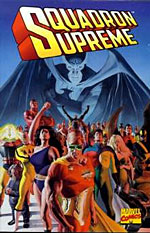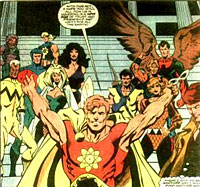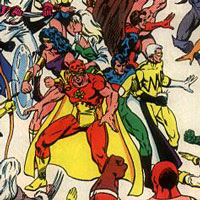>> The Friday Review: The Losers: Ante Up
>> The Friday Review: Marvels
More...

 Writer: Mark Gruenwald
Writer: Mark Gruenwald
Artists: Bob Hall, Paul Ryan, John Buscema, John Beatty, Jackson Guice, Sam
De La Rosa
Letterer: Janice Chiang, Rick Parker
Colourist: Christie Scheele
Collecting the 1985/1986 SQUADRON SUPREME maxiseries
Price: $24.95
Publisher: Marvel Comics
ISBN: 078510576X
It would appear that I'm asking for trouble by reviewing this book hot on the heels of SUPREME: THE STORY OF THE YEAR. You see, there are points of commonality between the two books (aside from the fact that they each feature 'supreme' in the title). Both sport covers by Alex Ross, and feature new takes on familiar characters in order to comment on the evolution of the superhero genre. However, where the two diverge is in approach; STORY OF THE YEAR revelled in the minutiae of the genre, while SQUADRON SUPREME is seen as an early stab at 'realism' in American superhero comics.
According to Mark Waid, SQUADRON SUPREME was "a groundbreaking piece of work... [we had] characters that were truly flawed, heroes that lived in a world where actions had consequences..."
However, the world that the Squadron exists in is not our world per se, nor in the Marvel universe that stands in for our world in the company's usual continuity. The Squadron occupy an alternate world, and as such, the actions and consequences Waid comments on fail to have the impact that a book set in 'our' world would. I'll come back to that point later, though.
 The Squadron are essentially Marvel's literal rip-off of DC's Justice League - that is, the classic version from the 60s and 70s. They were introduced in the pages of the AVENGERS in the late 60s, and were only seen sporadically until the 80s, where they were featured in a DEFENDERS storyline, involving the Squadron's being duped into assisting a takeover of their Earth.
The Squadron are essentially Marvel's literal rip-off of DC's Justice League - that is, the classic version from the 60s and 70s. They were introduced in the pages of the AVENGERS in the late 60s, and were only seen sporadically until the 80s, where they were featured in a DEFENDERS storyline, involving the Squadron's being duped into assisting a takeover of their Earth.
Of course, the heroes won the day, but the Squadron's world was left in the proverbial ruins. It wasn't until Mark Gruenwald opted to examine the fallout of such an action that readers saw how a band of gaudily clad adventurers might go about really trying to 'fix' the world. In the SQUADRON SUPREME maxiseries collected here, the various members agree to enact 'the Utopia program', in which they plan to deal with the world's various ills - war, starvation, disease, crime - by taking over the US Government. Giving themselves one year deadline, the Squadron attempt to rebuild their society. Of course, it wouldn't be a superhero book if they didn't meet some obstacles along the way...
Much of the promotional hype revolving around the re-release of SQUADRON SUPREME (and J Michael Straczynski's reworking of the concept, SUPREME POWER) suggests that if it weren't for this book's existence, we wouldn't have the likes of WATCHMEN, THE DARK KNIGHT RETURNS or THE AUTHORITY -and that's a hard row to plough, any way you look at it. While Gruenwald's reach has to be admired, his grasp lets him down.
 Gruenwald is a prime example of the kind of journeyman writer that the comic industry threw up during the course of the 80s. He had no real personal style to speak of, choosing instead to stick with the lingua franca established by Lee, Thomas, Englehart, et al. Where he excelled, though, was ideas - Gruenwald was never afraid to think big, with SQUADRON SUPREME serving as testament to his attempts to reach beyond the limitations of the genre he loved. That said, SQUADRON SUPREME suffers from a tendency to waver this way and that, not sure if it's social commentary, speculative fiction, or just a plain old guys-in-tights punch-out.
Gruenwald is a prime example of the kind of journeyman writer that the comic industry threw up during the course of the 80s. He had no real personal style to speak of, choosing instead to stick with the lingua franca established by Lee, Thomas, Englehart, et al. Where he excelled, though, was ideas - Gruenwald was never afraid to think big, with SQUADRON SUPREME serving as testament to his attempts to reach beyond the limitations of the genre he loved. That said, SQUADRON SUPREME suffers from a tendency to waver this way and that, not sure if it's social commentary, speculative fiction, or just a plain old guys-in-tights punch-out.
Much of the problems lie in the fact that SQUADRON SUPREME takes place in an alternate world - place names and the like have been changed (just for the sake of change, it seems), and as such it fails to anchor the reader in a believable setting. In the book's second half, there's a knockdown drag-out fight between Hyperion and his evil doppelganger (don't ask), which results in the destruction of Mount Rushmore. What could be a genuinely 'gosh-wow-cool' moment is mitigated by the fact that it's not 'our' world, and that the Squadron can easily fix it.
It also doesn't help matters that the artwork is unfortunately inconsistent. The first few chapters - illustrated by Bob Hall and John Beatty - feature some excellent moody storytelling, doing more to establish the Squadron's 'separate' reality than Gruenwald's prose could achieve. Once Paul Ryan and Sam De La Rosa take over the art chores, though, the quality drops noticeably, becoming an unsatisfying mish-mash.
While one must give credit to Gruenwald's willingness to push the envelope with SQUARDON SUPREME, the whole does not add up to the sum of its parts. SQUADRON SUPREME hasn't dated at all well, and in the wake of recent world events, some of the sentiments expressed in the collection come across as horribly simplistic. If anything, it reads like a superhero comic with extreme delusions of grandeur - and lord knows there are enough of those in the marketplace already.

This article is Ideological Freeware. The author grants permission for its reproduction and redistribution by private individuals on condition that the author and source of the article are clearly shown, no charge is made, and the whole article is reproduced intact, including this notice.


